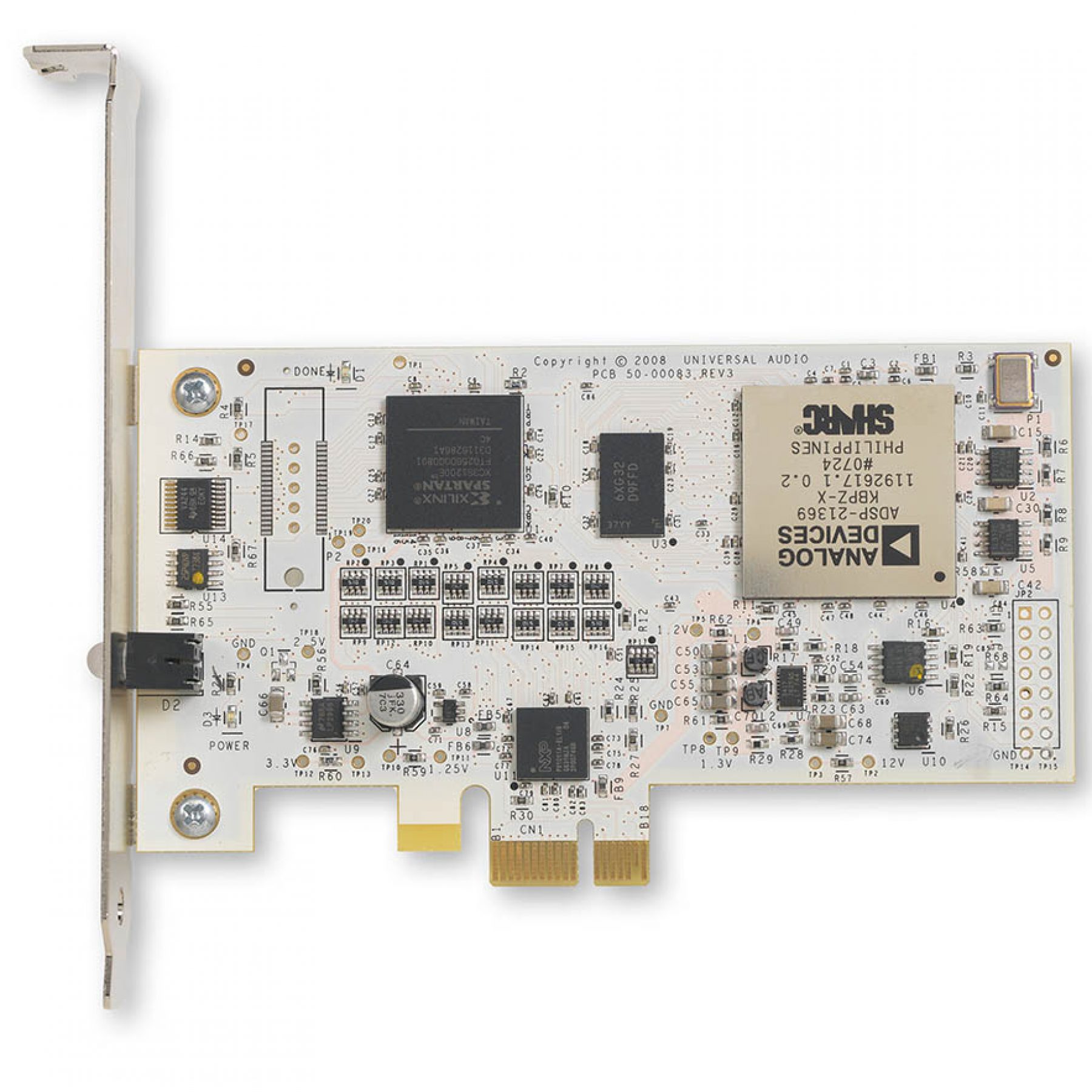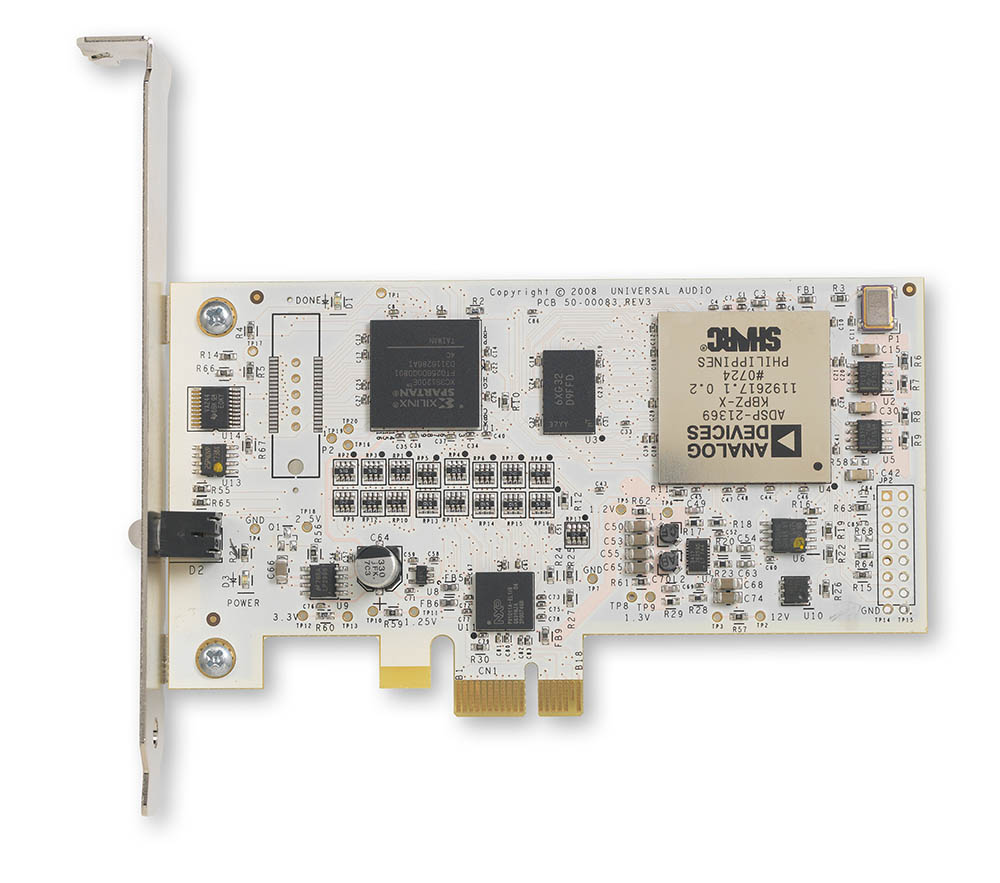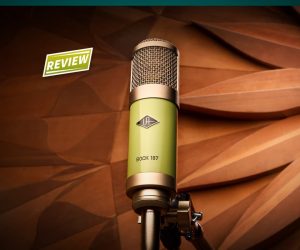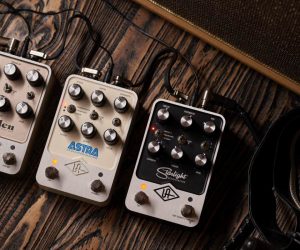
UNIVERSAL AUDIO UAD-2 SOLO/LAPTOP & QUAD
A new generation of UAD hardware is finally here, and not a moment too soon.
Text: Callum Orr
Let me put things in perspective. I’ve been awaiting the release of the UAD-2 Solo/Laptop for a long time now. In November ’07 I moved from mixing and mastering music on a PC desktop machine to a MacBook Pro. At that time I figured I’d be able to happily run my four UAD-1 cards via the MacBook Pro’s ExpressCard slot with the aid of a PCI expansion chassis from Magma. Wrong! A mismatch somewhere on the great ‘firmware dating’ site in the sky put paid to that idea and I’ve been hobbling along on one – yes one – UAD-1 card ever since. I’ve also been running occasional projects back on the old PC using outdated software just to get the grunt required – a little galling but unavoidable.
I’ve been using the UAD-1 plug-ins for, jeez… nearly 10 years now and with the arrival of the UAD-2 hardware relief is finally at hand. These days, literally all my mixing and mastering jobs utilise UAD plug-ins of one type or another. The company’s compressors, EQs and reverbs are all top quality. So when the new range of UAD cards was handed to me recently in a plain brown box with a nonchalant “there ya go” from Andy Stewart, I was more than eager to put them straight to work. Expectations were high and the wait had been long… tortuously long.
It goes without saying that I’m a bit of a UA plug-in fan, so it was a nice surprise to discover that the newly released 5.4 software also includes review licenses for three new plug-ins: the EMT 250 digital reverb emulation, the Neve 31102 EQ and Empirical Labs’ EL7 Fatso tape simulator and dynamics emulation. Awesome! I’m totally in awe of the EMT 250 already, but more on that later.
NEW SOFTWARE HARDWARE
The UAD-2 Solo/Laptop is an ExpressCard/34 device designed specifically for, well… laptops. The device is about the size of a segment of Lindt chocolate attached to a credit card, if you can picture that, which gives you 21/2-times the capacity of a UAD-1.
The first thing I immediately noticed about the UAD-2 Solo/Laptop was the improved speed and smooth running of my mastering chains. The increased processing headroom immediately alleviated the strain many of my recent sessions had suffered under, but unfortunately, projects that had previously been driven by four UAD-1 cards back on the PC still weren’t co-operating… bummer. After contemplating this persistent processing shortfall I’ve since discovered that Universal Audio has a UAD-2 Quad for laptop in the pipeline – an enticing prospect indeed.
Protruding the way it does from a laptop’s ExpressCard slot, and being as rigid as it is, my only concern with the physical design of the Solo/Laptop is that moving a computer about while it’s connected might potentially lead to disaster. I have visions of placing my MacBook down on a desk, with a pen or a mic lead accidentally caught under the protruding UAD-2 card and snap! For this reason alone I think I would have preferred to see the Lindt-sized processing hub connected to the ExpressCard host via a flexible cable. Aside from this concern, it’s been smooth sailing with the Solo/Laptop.
THE BIG GUNS
The other UAD-2 card I’ve been using over the last month has been the UAD-2 Quad. The Quad is the new granddaddy, a powerhouse card that contains four of the new SHARC chips where the Solo has only one – or in UAD-1 terms, 10-times the power. With the Quad card running the show on my old PC, my aforementioned pre-existing Cubase 4 and Sonar 6 sessions, which had previously pushed the four UAD-1 cards to the brink, ran without a hitch. What’s more, because the sessions were playing back with ample DSP overhead, they somehow seemed less stressed and better sounding. Or maybe it was just me who was less stressed; all the memories of trying to get a mix over the line with four max’ed out UAD-1s in Logic or Cubase came flooding back, and they weren’t fond ones, believe me!
With the Quad card providing ‘an extra six UAD-1s worth of headroom’, I set about basking in the glow of the extra DSP by loading a bunch of new plugs from more recent UA software releases. Having this extra system headroom was a relief and a real bonus.
With some re-energised mixes uploaded to past clients as a value-added remix favour, I then set about mixing completely new material, again using the Quad via my PC setup. As a test of its power I decided to use nothing but UAD plug-ins for an entire mix. The first of these wound up running 48 mono plug-ins, with a further 12 stereo plugs on some stereo signals like overheads, acoustics, effects returns and buses. Of course, heaps of DSP is never enough and it goes without saying that I eventually maxed out the single Quad card. Hey, I wouldn’t be doing my job if I hadn’t.
MAD MAX-2
In the same way as you could with the UAD-1 card, it’s easy enough to add more UAD-2s to a system provided your wallet can cope. In fact, a single system can now run up to four UAD-2 and four UAD-1 cards. This represents a serious amount of grunt – 44 times the power of a single UAD-1 by my calculations. However, at a little over $2500 for a single Quad, a system of this size will set you back a pretty penny. Ten grand, to be exact!
To this end, I reckon a UAD-2 ‘Deca’ should be the next release on the cards (if you’ll pardon the unfortunate pun). This would give the next release from UA 25 times the power of a UAD-1 on a single card and 100 times the power if you had four! This may seem like a throwaway and churlish comment, but already there are some voices criticising Universal Audio’s decision to use the SHARC chip, when other chips were available that could have provided the plug-ins with many times the SHARC chip’s capabilities.
THREE NEW PLUG-INS
Speaking of plug-ins, new to the ever-expanding UAD software emulation empire are three new plugs in version 5.4. First cab off the rank is the EMT 250 digital reverb, which is, in a word, superb. From the moment I clapped ears on it I began to wonder if I hadn’t heard its sonic signature before on records like Beck’s Seachange and Mutations – the EMT 250 hardware unit at the source of this emulation is, after all, housed at Ocean Way where Beck recorded and mixed these albums with acclaimed Radiohead producer, Nigel Godrich. Although I suspect there’s probably also a judicious use of Lexicon 480L on these records, after using the EMT 250 emulation myself, I don’t believe Mr Godrich could have passed up the opportunity to use the original!
Just to fill you in on some history, Ocean Way Studios and Universal Audio have a very long association that began with Bill Putnam Senior owning the original studio and premises that now contain Ocean Way. These days Bill Putnam Jr and Ocean Way owner, Allen Sides, collaborate on software emulations of hardware classics such as the beloved Fairchild 670 and now the EMT 250.
From the moment I patched in the EMT 250 it was obvious this was a classic sounding reverb. Deep, interesting and never ho-hum, the algorithms developed way back in 1976 by Dr Barry Blesser still sound great today. I can always find something in a mix that can do with a healthy dose of EMT, and between this and the UA Plate 140 and Dreamverb, I really don’t need any other reverbs (though I still use the excellent Platinum reverb and Space Designer Convolution reverb built into Logic Pro).
Special mention must also go to the EMT 250’s graphic display, which does a great job of emulating the appearance and mechanical workings of the original unit. Virtual arc faders like the ones found on ’60s EMI consoles provide delay, pre-delay and low and high-pass filter control with five buttons for engaging different effects such as Chorus, Delay, Phase, Echo and Space. The 250 looks very ‘schwing’ but some may argue that it takes up too much screen real estate.
NEVE 31102 EQ
The new Neve 31102 EQ plug-in and its ‘lite’ cohort, the 31102SE, are also welcome additions to UA’s already impressive Neve emulation suite. Modelled on Class-A/B architecture from the late ’70s, the 31102 has a flavour all its own. It has a nice hard sound when you push the boost over +9dB, plenty of solid tone and a less pronounced top-end sheen thanks to the frequency selections and topologies, which differ from the more familiar Neve 10-Series EQs.
I’ve used the real version of this EQ in Dave Clooney’s Atlantis studios in Port Melbourne where I’ve previously had great results on bass, snare and vocals. I didn’t manage to get the plug-in and the original hardware side by side, unfortunately, but the UAD plug-in certainly operates and sounds similar to my memory of the original. Next to bass and vocals, electric guitars have received the most 31102 processing. The EQ delivers grunt but never at the expense of clarity – perfect for electric guitars. The 31102 also has some serious attitude between 100 and 300Hz without generating mud. I also like the way you can get rid of top-end wispiness without affecting the midrange sheen. All in all it’s a very useful EQ that’s optimised nicely for the UAD-2 Quad, allowing you to get quite a lot of instances.
The Crème de la crème and probably the most anticipated of the three new plug-ins is the Empirical Labs EL7 Fatso Jr/Sr. Many users have had tape emulation on their UA wish-list for a long time now, and UA has finally come through with the goods, producing a faithful rendition of Dave Derr’s modern classic. I’ve been strapping the ‘Senior’ version of this plug-in over the output bus of several of my recent mixes and I can happily report that it has sounded beautiful on almost every mix. It’s also been great on individual mix elements like weedy acoustic guitars and bland backing vocals – improving their tone and attitude significantly.
NO NUMBER CRUNCHING
I’m going to resist the temptation here of getting caught up in descriptions of how many instances of which plug-ins can be achieved with the three new UAD-2 card options; Universal Audio has that information on its website if you’re interested. I will point out, however, that with the advent of the UAD-2 a couple of negatives have crept into calculations. Firstly, for licensing reasons only UA understands, the Nigel guitar simulator and all of its plug-in modules have been discontinued for use on the UAD-2 platform. Secondly, it seems many of the new plug-ins will no longer run on the UAD-1. Already the Cooper Time Cube, EL7 Fatso Jr and EMT 250 are restricted to the UAD-2 platform only.
It’s a fact of life I suppose that I’m now on a UAD hardware upgrade treadmill. But since UA plug-ins are some of the finest going around I’m happy to bite the bullet. Would I have preferred a larger boost in power from the UAD-1 to UAD-2 Solo? Yes. For now though, I’m quite content pursuing my new threshold of ‘maxed-outness’. With the Quad card in particular, you’re a lot further into a mix before you start having to go down the ‘bounce plug-in to disk’ route. Call me weird, but such is my commitment to the UAD platform I’m now aiming to purchase an 8-Core MacPro running two UAD-2 Quads. For us ol’-timer UAD-1 users, that’s the equivalent of 20 UAD-1s. Some may snicker, others will marvel.

















RESPONSES